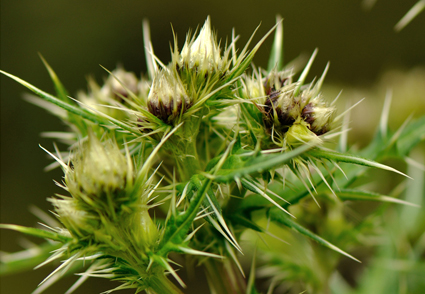Abstract
Through the examination of specimens (including type materials), we proved that Cirsium chrysolepis is indistinguishable from C. nishiokae, and C. lipskyi is conspecific with C. interpositum and is the legitimate early name for the species. Therefore, we relegate C. chrysolepis to the synonymy of C. nishiokae and C. interpositum to the synonymy of C. lipskyi.
References
<p>Hajra, P.K. (1995) <em>Cirsium</em> Mill. <em>In</em>: Hajra, P.K., Rao, R.R., Singh, D.K. & Uniyal, P.B. (Eds.) <em>Flora of India</em>, vol 12. Botanical Survey of India, Calcutta, pp 167−172.</p>
<p>Hooker, J.D. (1881) <em>Cnicus</em> L. <em>In</em>: Hooker, J.D. & Clarke, C.B. (Eds.) <em>The Flora of British India</em>, vol. 3. Reeve & Co. Ltd. England, pp. 362−364.</p>
<p>Kitamura, S. (1968) Compositae of Southeast Asia and Himalayas II. <em>Acta Phytotaxonomica et Geobotanica</em> 19: 65−81.</p>
<p>Kitamura, S. (1974) New <em>Crisium</em> from Nepal. <em>Acta Phytotaxonomica et Geobotanica</em> 26: 16−17.</p>
<p>Miller, P. (1754) <em>The Gardeners Dictionary</em> (4th ed.), vol. 1, corrected and enlarged. Printed for the author, London.</p>
<p>Petrak, F. (1911) Über eine neu Art der Gattung <em>Cirsium</em> aus dem Nördlichen Indien.<em> Repertorium Specierum Novarum Regni Vegetabilis</em> 9: 197−199. https://doi.org/10.1002/fedr.19110091303</p>
<p>Petrak, F. (1938) Über eine neue, in phylogenetischer Hinsicht sehr interessante Art der Gattung <em>Cirsium</em> (<em>C. interpositum</em>) aus China.<em> Repertorium Specierum Novarum Regni Vegetabilis</em> 43: 283−285. https://doi.org/10.1002/fedr.19380431706</p>
<p>Shi, Z. & Greuter, W. (2011) <em>Cirsium</em> Mill. <em>In</em>: Wu, Z.Y. & Raven, P.H. (Eds.) <em>Flora of China</em>, vols. 20−21. Science Press, Beijing & Missouri Botanical Garden Press, St. Louis, pp. 160−175.</p>
<p>Shih, C. (1984) Notulae de plantis tribus Cynarearum familiae Compositarum sinicae (II). <em>Acta Phytotaxonomica Sinica</em> 22: 386−396.</p>
<p>Shih, C. (1987) <em>Cirsium</em> Mill. <em>In</em>: Ling, Y. & Shih, C. (Eds.) <em>Flora Reipublicae Popularis Sinicae</em>, vol. 78 (1). Science Press, Beijing, pp. 78−135. [In Chinese]</p>
<p>Turland, N.J., Wiersema, J.H., Barrie, F.R., Greuter, W., Hawksworth, D.L., Herendeen, P.S., Knapp, S., Kusber, W.-H., Li, D.-Z., Marhold, K., May, T.W., McNeill, J., Monro, A.M., Prado, J., Price, M.J. & Smith, G.F. (eds.) (2018) <em>International Code of Nomenclature for algae, fungi, and plants (Shenzhen Code) adopted by the Nineteenth International Botanical Congress Shenzhen, China, July 2017</em>. Regnum Vegetabile 159. Koeltz Botanical Books, Glashütten. https://doi.org/10.12705/Code.2018</p>
<p>Hooker, J.D. (1881) <em>Cnicus</em> L. <em>In</em>: Hooker, J.D. & Clarke, C.B. (Eds.) <em>The Flora of British India</em>, vol. 3. Reeve & Co. Ltd. England, pp. 362−364.</p>
<p>Kitamura, S. (1968) Compositae of Southeast Asia and Himalayas II. <em>Acta Phytotaxonomica et Geobotanica</em> 19: 65−81.</p>
<p>Kitamura, S. (1974) New <em>Crisium</em> from Nepal. <em>Acta Phytotaxonomica et Geobotanica</em> 26: 16−17.</p>
<p>Miller, P. (1754) <em>The Gardeners Dictionary</em> (4th ed.), vol. 1, corrected and enlarged. Printed for the author, London.</p>
<p>Petrak, F. (1911) Über eine neu Art der Gattung <em>Cirsium</em> aus dem Nördlichen Indien.<em> Repertorium Specierum Novarum Regni Vegetabilis</em> 9: 197−199. https://doi.org/10.1002/fedr.19110091303</p>
<p>Petrak, F. (1938) Über eine neue, in phylogenetischer Hinsicht sehr interessante Art der Gattung <em>Cirsium</em> (<em>C. interpositum</em>) aus China.<em> Repertorium Specierum Novarum Regni Vegetabilis</em> 43: 283−285. https://doi.org/10.1002/fedr.19380431706</p>
<p>Shi, Z. & Greuter, W. (2011) <em>Cirsium</em> Mill. <em>In</em>: Wu, Z.Y. & Raven, P.H. (Eds.) <em>Flora of China</em>, vols. 20−21. Science Press, Beijing & Missouri Botanical Garden Press, St. Louis, pp. 160−175.</p>
<p>Shih, C. (1984) Notulae de plantis tribus Cynarearum familiae Compositarum sinicae (II). <em>Acta Phytotaxonomica Sinica</em> 22: 386−396.</p>
<p>Shih, C. (1987) <em>Cirsium</em> Mill. <em>In</em>: Ling, Y. & Shih, C. (Eds.) <em>Flora Reipublicae Popularis Sinicae</em>, vol. 78 (1). Science Press, Beijing, pp. 78−135. [In Chinese]</p>
<p>Turland, N.J., Wiersema, J.H., Barrie, F.R., Greuter, W., Hawksworth, D.L., Herendeen, P.S., Knapp, S., Kusber, W.-H., Li, D.-Z., Marhold, K., May, T.W., McNeill, J., Monro, A.M., Prado, J., Price, M.J. & Smith, G.F. (eds.) (2018) <em>International Code of Nomenclature for algae, fungi, and plants (Shenzhen Code) adopted by the Nineteenth International Botanical Congress Shenzhen, China, July 2017</em>. Regnum Vegetabile 159. Koeltz Botanical Books, Glashütten. https://doi.org/10.12705/Code.2018</p>


